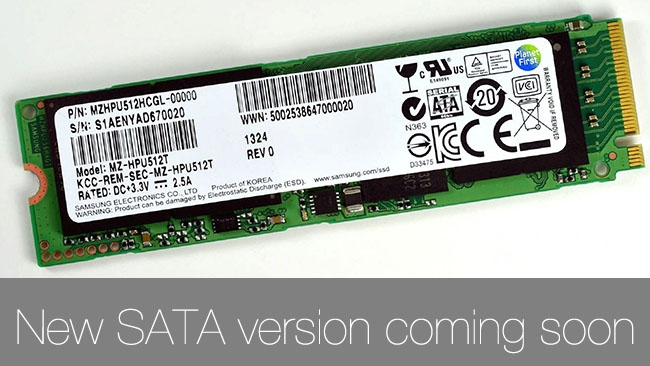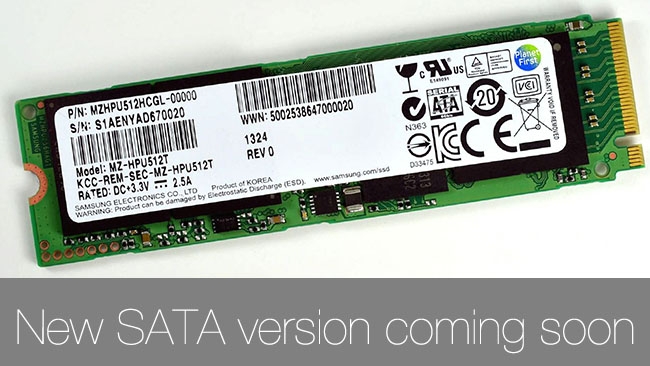
 New SATA 3.2 standard
New SATA 3.2 standard
SATA-IO, the industry consortium that develops the SATA specifications, have just ratified the next version, SATA 3.2, with support for higher transfer speeds and new form factors
Since SATA (Serial Advanced Technology Attachment) was first introduced ten years ago it has become the most common way of attaching storage devices to the motherboards of computers. Most hard drives and SSD's currently use the SATA 3 specification which allows for transfer speeds of up to 6Gb/s
SATA-IO, the organisation in charge of developing SATA have just ratified the next version of SATA, version 3.2, which will allow data transfer at speeds of up to 16Gb/s and support for smaller form factors in portable devices.
The new version includes "SATA Express" which allows SATA devices to connect directly the PCIe bus and communicate without going through a controller. It also includes support for hybrid SSD/Hard drive solutions and small form factor SSDs for portable devices.
Another useful function is "DevSleep" which will put the SATA device into a very low power state to save power but it can resume full operation almost instantly, allowing a notebook to resume from sleep very quickly.
You can read the full press release after the break:
SATA-IO Unveils Revision 3.2 Specification
Latest SATA Specification Includes SATA Express, New Form-Factors, Power Management
Enhancements and Optimizations for Solid State Hybrid Drives
Beaverton, Ore. – August 8, 2013 – Serial ATA International Organization (SATA-IO), the
industry consortium dedicated to sustaining the quality, integrity and dissemination of Serial
ATA (SATA™) technology, today announced the ratification of its revision 3.2 specification. The
latest specification includes SATA Express, a new specification that enables the coexistence of
SATA and PCIe storage devices, as well as enhancements in power management, new SATA
form-factors, and optimizations for solid state hybrid drives (SSHDs).
"SATA technology continues to evolve to accommodate ever-changing storage industry
requirements," said Mladen Luksic, SATA-IO President. "The updates featured in the revision
3.2 specification, such as SATA Express and enhancements for emerging solid state hybrid
drives, are driven by current market trends. These new features demonstrate SATA-IO's
ongoing commitment to providing low-cost, high-performance storage solutions."
Initially introduced in January 2013, the SATA Express specification enables a client storage
ecosystem that allows SATA and PCIe solutions to coexist. A host implemented to this
specification will connect to and function with either a SATA or PCIe storage device. PCIe
technology enables increased interface speeds of up to 2GB/s (2 lanes of PCIe 3.0), compared
with today's SATA technology at 0.6GB/s (6Gb/s). The increased speed of PCIe provides a
cost-effective solution for optimizing performance of Solid State Drives (SSDs) and emerging
SSHDs. Storage devices not requiring the increased speed of PCIe, such as traditional hard
disk drives (HDDs) and optical drives, will continue to be supported by SATA.
SATA revision 3.2 also incorporates the M.2 form factor, enabling small form-factor M.2 SATA
SSDs suitable for thin devices such as tablets and notebooks. M.2 (formerly known as NGFF and defined by PCI-SIG®) is a small form factor card that supports a variety of applications
including WiFi, WWAN, USB, PCIe and SATA.
Additional key features and enhancements of revision 3.2 include:
microSSD – standard for embedded solid state drives (SSDs) that enables developers
to produce single-chip SATA implementations for embedded storage applications.
Universal Storage Module (USM) – enables removable and expandable storage for
consumer electronic devices. SATA revision 3.2 introduces USM Slim, which reduces
module thickness, allowing smaller removable storage solutions.
DevSleep – the lowest yet level of power management where the drive is almost
completely shut down, to meet the requirements of new always on, always connected
mobile devices such as Ultrabooks™.
Transitional Energy Reporting – provides the host with detailed information about the
SATA storage device, facilitating better power management.
Hybrid Information – provides a mechanism in which the host can communicate data
caching information to the drive, improving solid state hybrid drive (SSHD) performance.
Rebuild Assist – speeds the data reconstruction process in RAID configurations.
For more information on revision 3.2 and the complete SATA ecosystem, visit SATA-IO at booth
#806 at the Flash Memory Summit on August 13-15, 2013 in Santa Clara, CA. SATA-IO will
also be presenting "SATA v3.2: SATA Evolves" in the Standards session on August 13 from
4:35 to 5:45 p.m. at the event.
SATA specifications are available for members to download at no cost. Non-members may
purchase the specification for a nominal fee. To access the SATA specifications, visit SATA-IO
Website Downloads. For more information on SATA technologies, visit http://www.sataio.org/technical-overview.
Tags: Technology


Comments